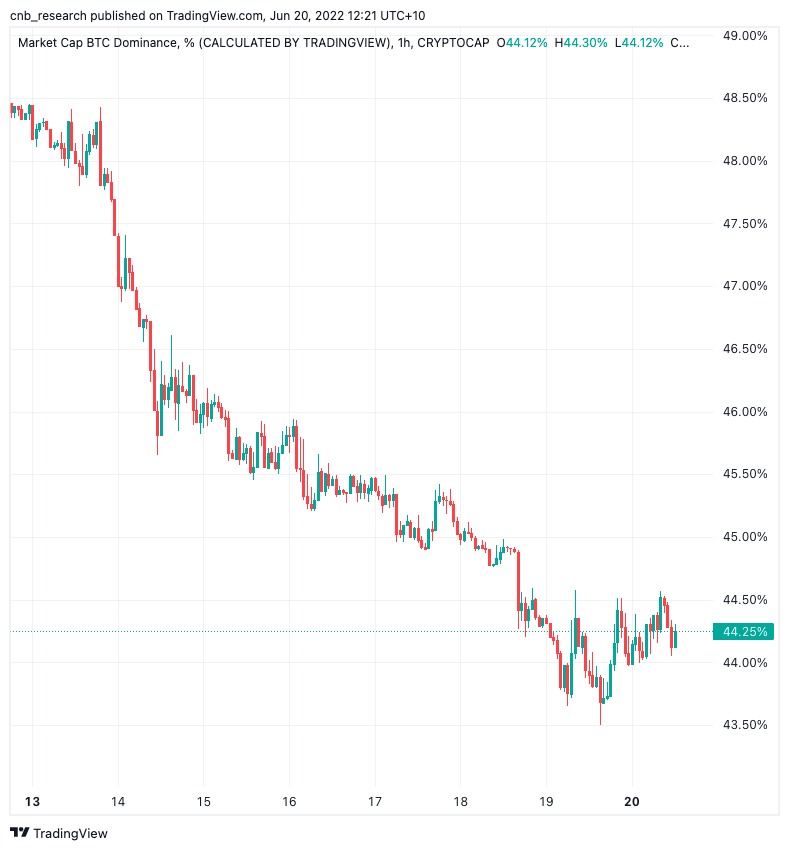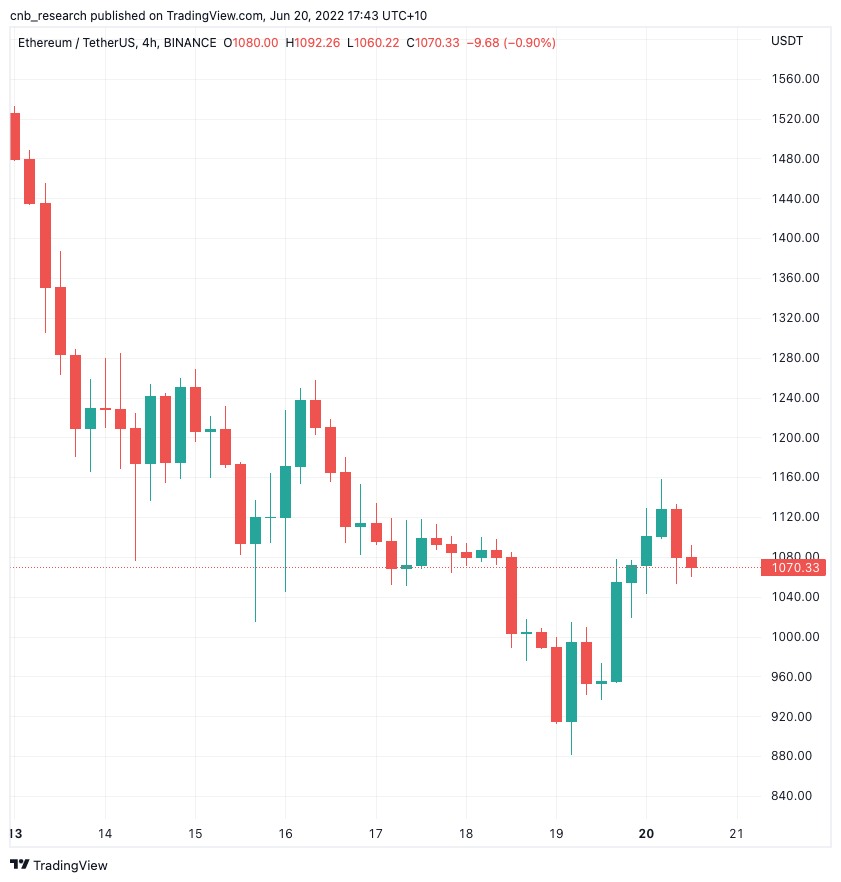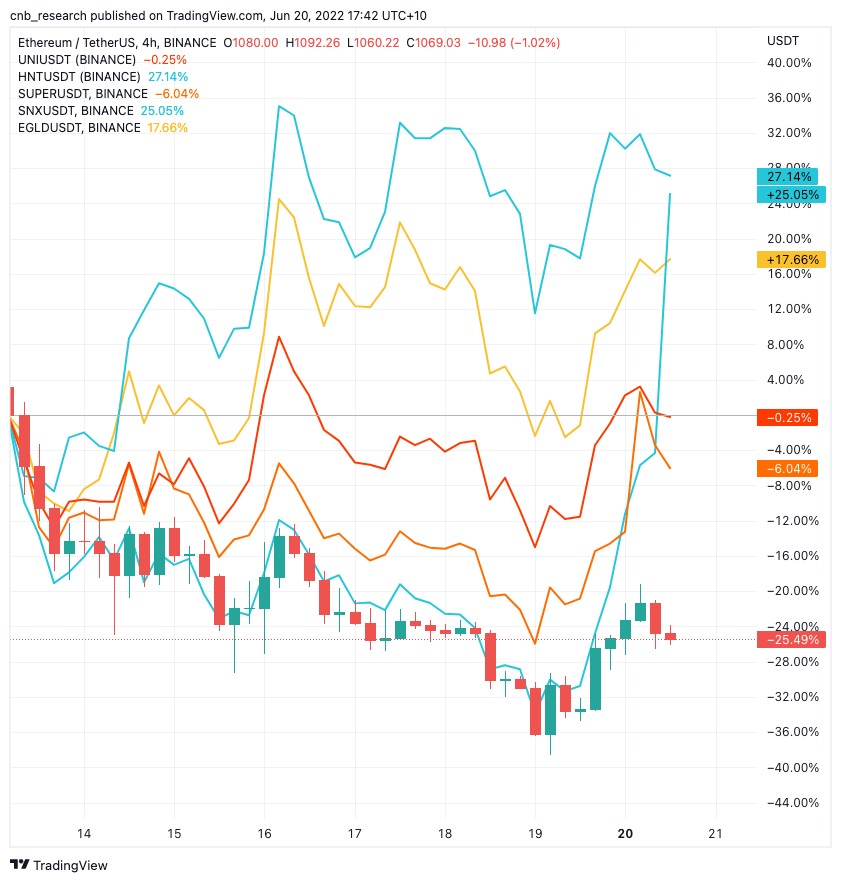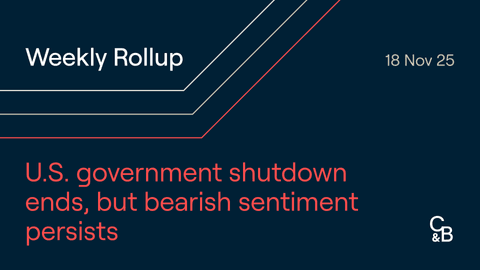In this Week's Market Update
Last week's downtrend has been further exacerbated by continued unfavourable macroeconomic conditions, as investors rotate into alternative asset classes. Growing fears of cascading market dynamics, lead by insolvency issues of two major crypto players have added further fuel to the fire. BTC and ETH have been affected worse than altcoins as many large crypto funds have been forced to sell their most liquid positions to reduce market exposure.
Macroeconomic Updates
- The U.S. Fed raised the cash rate by 75 bps, the biggest single increase since 1994 and in direct response to record inflation of 8.6% in the U.S. alone. It is expected that many major economies’ reserve banks will move interest rates in line with this movement.
- Commodities have trended down since last week with gold now trading at USD$1,840, down 2% and Crude Oil WTI finishing the week at USD$110, down almost 8%.
- Major stock indices such as the S&P 500 and Nasdaq have retraced 23.89% and 33.65% from their highs in November 2021. This is the lowest level these markets have traded at since late 2020, indicating that there has been a significant devaluing of traditional assets in line with falling business confidence and rising interest/inflation rates.
Crypto Market Updates
- Celsius has fallen into the scopes of regulators across five states after freezing withdrawals on their platforms last week, allegedly resulting in “financial consequences” for their users.
- Tesla and SpaceX are facing a legal battle and a potential USD$258 billion lawsuit after Elon Musk is accused of promoting Dogecoin (DOGE) on his twitter account numerous time, manipulating the price of the cryptocurrency.
- BTC fell as low as USD$17,635 and ETH fell below the key support level of USD$1,000. These represent significant new lows which have not been seen since December 2020.
- The crypto industry continues to be hit with major job layoffs following the recent market downturn, as both Coinbase and BlockFi announced plans to cut their workforces by 20%.
Market Overview
The total crypto market cap has fallen over 7% in the past 24 hours to approximately USD$867 billion. This takes the value of all cryptocurrency assets to price levels not seen since December 2020.
Bitcoin (BTC)
Bitcoin suffered one of its worst weeks in recent history, falling approximately 37% from USD$28,000 to USD$18,000. The macroeconomic backdrop of increasing inflation and rising interest rates has seen alternative assets become heavily devalued as investors rotate into other asset classes. The S&P has retraced to pre-pandemic levels, retracing 23.4% YTD to 3674.8 which was last noted in early December 2020. Though BTC’s sell-off has largely been driven by deteriorating macroeconomic conditions, solvency issues in centralised crypto companies have added further fuel to the fire. There is growing concerns amongst investors and traders alike of cascading market dynamics following news of leading crypto lending platform Celsius being unable to cover their short term debt obligations, and prominent hedge fund Three Arrows Capital (3AC) having several significant margin positions liquidated. As two major players across the crypto space, speculation of insolvency has sparked fear across the market, contributing to selling pressure.

Normally in crypto market sell offs, BTC is a sold off at a lesser extent to other altcoins, however, this was not the case in the last week as reflected by the above chart measuring the decline in BTC’s dominance in terms of total cryptocurrency market cap. Bitcoin dominance dropped over 5% from 48.5% at the beginning of the week to 43.5%, indicating that altcoins outperformed BTC during the recent downturn. A potential reason for this irregular move is that large crypto funds may have been forced to sell some of their most liquid assets (mainly Bitcoin) to cover redemptions and/or to reduce their long exposure. We have seen some evidence to support this assumption, as the BTCC - Purpose Bitcoin ETF was forced to sell 24,500 BTC (almost USD$500 million) last Friday.
Ethereum (ETH)
ETH was amongst the worst performers this week, falling as low as 44.5% since last week to USD$897, a price we have not crossed since early January ‘21. It has since rebounded 24%, now trading at approximately USD$1,100. This may be attributed to the current fears surrounding Lido’s Staked ETH (stETH) and the mismanagement of leveraged positions in these pools. As liquid assets became prioritised by investors, liquidity pools such as Curve Finance’s stETH:ETH pool were drained of ETH, contributing to an 80% drawdown in just 45 days. This coupled with major market players covering their leveraged stETH positions by selling more stETH, led to the stETH:ETH pair depegging. Thus, causing panic amongst investors.

The spotlight has remained on lending platform, Celsius, after it froze withdrawals last week, now concerning regulators in five US states who have begun investigating the incident. The Texas State Securities Board director of enforcement, Jospeh Rotunda told Reuters the “inability to access their investment may result in significant financial consequences” and they are now making it a “priority” to investigate Celsius. Crypto analysts also identified a wallet linked to Celsius transferring 104,000 ETH (USD$111 million) to the FTX trading platform, raising further fears amongst traders that they may offload their ETH assets (and potentially force the price down) in an effort to offset their liquidity troubles.
Market Sectors
Defi cryptocurrencies have been the strongest performing sector this week, trading 0.5% higher. Synthetix (SNX) led the way, increasing 25.05%. The Total Value Locked (TVL) in DeFi protocols has fallen 45% since the start of June, currently at USD$71.98 billion. Defi’s strong performance in the face of a significant reduction in TVL stems from Defi protocols functioning smoothly despite significant market volatility. This is in contrast to centralised lending services like Celsius, that have been forced to suspend withdrawals.

While the Gaming and Smart Contract Platform sectors also showed signs of recovery from the weekend selloff, both remain 5.13% and 6.95% below last week’s prices. Most notably were SuperFarm (SUPER) and Elrond (EGLD) up 20.6% and 18.4% respectively, in the last 24 hours. The Web3 sector has shown the strongest recovery from last week’s lows, up an impressive 9%! This was led by Helium (HNT) which is trading 32.8% higher week-on-week.
NFTs
NFTs have also continue to trend down alongside the crypto market. OpenSea, the largest marketplace for NFTs, have only traded just shy of USD$500 million for the month so far. This is only 20% of the volume traded in the month of May. Despite the fall in NFT volume and price, the space continues to gain attention from major brands wanting to integrate themselves with the innovative smart contract technology. Most recently has been Swiss luxury watchmaker TAG Heuer, who is working with the Bored Ape and Clone-X communities to produce a smart watch which will connect to the blockchain and display NFTs. Additionally, France is aiming to utilise NFT ticketing as soon as the 2023 Rugby World Cup and 2024 Paris Olympics. This announcement comes in response to the recent UEFA Champions League final which saw mass ticket counterfeiting, resulting in chaotic crowds and a delayed game. France hopes to take advantage of the verifiable and distinct properties of NFTs, creating a seamless ticketing system.
Regulatory
Elon Musk is facing a USD$258 billion Dogecoin (DOGE) lawsuit by a DOGE investor. Musk’s companies SpaceX and Tesla have also been sued for promoting the “dogecoin pyramid scheme” and using his large influence to manipulate the price of Dogecoin for personal profit.
In other news, Kazakstan will launch a pilot program which will allow cryptocurrency exchanges to open bank accounts in their jurisdiction. The mission, as stated by the head of Astana Financial Service Authority (ASFA), Nurhat Kushimov, is to create a reliable and sustainable environment for these crypto companies to thrive.
Recommended reading: Bitcoin Basics: A Beginner's Guide
Disclaimer: This assessment does not consider your personal circumstances, and should not be construed as financial, legal or investment advice. These thoughts are ours only and should only be taken as educational by the reader. Under no circumstances do we make recommendation or assurance towards the views expressed in the blog-post. Past performance is not a reliable indicator of future results. The Company disclaims all duties and liabilities, including liability for negligence, for any loss or damage which is suffered or incurred by any person acting on any information provided.
from Caleb & Brown Cryptocurrency Brokerage.






